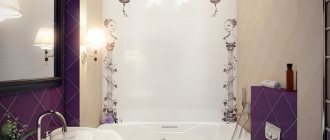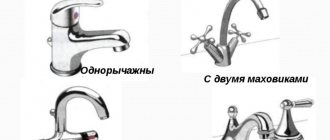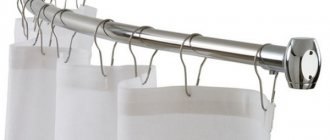Home / Tips
Back
Published: 04/28/2020
Reading time: 3 min
0
1351
It is natural for a person to arrange his home, while he strives to hide all utility networks as much as possible. In connection with this, the question is increasingly being asked on the Internet about whether it is possible to install a boiler in the bathroom.
In fact, this conclusion suggests itself to every developer when determining the option for installing boilers in a small house or apartment.
In practice, everything does not look so simple. The reason for this is the fact that there are still discrepancies on this issue in some state regulations.
In addition, there are established minimum standards for the size of the room, which is the starting point when deciding on installing a boiler in the bathroom.
- 1 Why a boiler in the bathroom
- 2 Rules and regulations 2.1 Reasons for prohibiting installation in the bathroom and toilet
- 2.2 Is it possible to bypass the ban?
- 2.3 What is provided for unauthorized installation
What types of heating devices are not suitable for a bathroom?
Types of equipment prohibited for installation in such premises include any gas units: water heaters, boilers, convectors. Therefore, the relevant services will most likely give a negative answer to the question of whether it is possible to install a gas boiler in the bathroom.
Gas boilers
According to government standards and regulations, such devices are not intended for indoor use.
It is not permitted to operate water heating devices powered by gas and equipped with open combustion chambers in rooms with forced ventilation. Although heating devices require good air exchange for proper functioning, the installation of supply fans cannot be combined with such equipment. The combustion process is disrupted, combustion products accumulate and there is a risk of poisoning with harmful substances. It is permitted to install such devices only in certain cases.
Gas water heater in the bathroom
As a rule, gas equipment specialists do not even agree to replace old products with newer ones.
Is it possible to install a boiler in a toilet?
You cannot install gas equipment in a toilet without official permits. However, under certain conditions, you can obtain permission to install such units.
Installation of a floor-standing gas boiler
If you are wondering whether it is possible to install a gas boiler in a bathroom or toilet, you need to consider the following requirements:
- Redevelopment of the premises and changes to technical documentation. When the Gas Service does not provide registration of the relevant heating equipment, you can try to change the status of the premises. “Converting” a bathroom into a storage room or change room and submitting an appropriate application to the BTI will immediately help solve the problem. If the technical passport of a house or apartment indicates the appropriate types of premises, there will be no refusal from government agencies. However, the presence of plumbing fixtures may result in a ban on the installation of a heating boiler. If only the toilet has been installed in the room, changing the plan will not cause any difficulties.
- Connecting new gas equipment . Provided that registered heating equipment is mentioned in the design of the premises, there will be no problems with installing a new boiler. It is much easier to replace an old device with a new one if permission for similar devices is already available.
Gas service technicians in some regions of our country may agree to install certain water heating systems in sanitary facilities. These must be special devices with a closed combustion chamber. Before selecting and installing such equipment, you must consult with gas specialists.
Wall-mounted gas boiler
Recommendations for installing gas equipment
First of all, it is recommended to carefully select the equipment for installation. For a bathroom, the best option is a double-circuit boiler with a closed combustion chamber. This type of equipment is best suited for small spaces. A wall-mounted boiler can be installed on an external wall, and gas exhaust and air intake are organized using one pipe, without large investments.
In order to separate the equipment from splashing water, it is recommended to fence off the boiler with a wall, this will ensure the safety of the boiler. When installing, comply with electrical safety requirements - the distance from the sink or bathtub must be at least 0.6 meters.
How to understand the documentation
The situation with permission to carry out installation is somewhat complicated by confusion in the official documentation. The fact is that the adopted Codes of Norms and Rules do not provide a clear explanation of whether gas boilers are allowed in bathrooms. Many employees of the state gas service refer to regulation 2.04.08 –87. It says about the ban on connecting gas boilers in bathrooms.
However, according to the resolution of the State Construction Committee of the Russian Federation dated December 23, 2002, the above documents and norms are considered invalid.
The new requirements (document 42-01-2002) do not contain clear instructions or a strict ban on the installation of gas equipment. As a result, misunderstandings arise. Some employees of the Gas Service simply refuse to install heating gas structures, without delving into the intricacies of the adopted documents and standards.
The process of installing and connecting a gas boiler
Without paperwork and collecting a large number of various permits, you can only install a new gas boiler or water heater in place of old appliances in the bathroom. In this case, if a place for such equipment is already provided, and, therefore, there is also permission, the employee will agree to make the connection.
Some nuances of installing flow-through gas heaters in the toilet and bathroom
For owners of private cottages, there is another way to obtain official permission to install a boiler or gas heater in the bathroom. First, official documentation is drawn up when developing the project.
Install gas equipment in the part of the home where it is permitted. Then plumbing fixtures, such as a bathtub, are installed next to the fixture and a plasterboard partition is built around it. Such an improvised redevelopment, of course, cannot be called ideal. Subsequently, if the owner wants to sell the house, a number of problems may arise. Specialists from the Bureau of Technical Inventory will be able to conduct an examination only after dismantling the walls.
Officially, installation of a gas boiler is provided only for technical premises - storage rooms, change houses. If such rooms meet the requirements adopted for them, the installation of gas-fired water heaters is permitted.
Appearance of a floor-standing gas boiler
High levels of humidity in the bathroom and temperature fluctuations often lead to breakdowns of gas heating appliances. Before deciding to install it, it is worth considering all the advantages and disadvantages and assessing the financial feasibility of installing such equipment. Obtaining official permission from the relevant authorities is not easy; this can be done by applying some legal tricks.
Why is there a boiler in the bathroom?
The state applies very strict requirements to gas equipment. SNIP sets out almost every installation step and every centimeter of room size that the developer must comply with.
This will be necessary for the owner to obtain permission to put the equipment into operation and obtain an operating permit from the gas supply organization.
Of course, it would be more correct to install the boiler in a special room in the furnace or boiler room, but the owner of a private house cannot always do this due to the limited area of the building. Most often boilers are installed in the kitchen.
Today, this option is also not suitable for everyone, since modular kitchen units are not able to hide the boiler in the kitchen, and their joint use spoils the newfangled interior.
In studio premises, the placement of gas equipment and a water heater is strictly prohibited, since the kitchen area is connected to the living area. In this case, the conclusion suggests itself - installing a boiler in the bathroom.
In fact, this is convenient, since modern gas boilers are double-circuit and are capable of not only heating rooms, but also heating water for domestic hot water needs.
Placing such units in the consumption area creates savings not only in building materials for piping equipment, but also in fuel due to the reduction in heat losses along the length of pipelines.
Today's legislation on this issue is vague, but it seems that saving energy resources and the desire of Russians for such an installation scheme will serve as the basis for legislators to establish specific standards for the installation of boilers in bathrooms, taking into account all existing limiting factors.
Installation of gas stoves in bathrooms
According to the documentation on working with heating systems, in the section on residential multi-storey buildings there are no clear prohibitions on the installation of this type of equipment.
Thus, a gas water heater in the bathroom is a completely suitable way to heat water.
Geyser on the wall in the bathroom
However, according to accepted state requirements, it is necessary to take into account many nuances when choosing a gas unit and when installing such a design. It is necessary to take into account the specific layout of the bathroom.
Certain provisions of the Code of Norms and Rules dated January 31, 2003 provide for the installation of gas equipment with a closed chamber type in multi-apartment buildings in the absence of such buildings being connected to a central or individual heat supply system .
At the same time, heat sources and water heaters using natural fuel are allowed to be connected in some rooms. This is specified in paragraph 7.3.8. SNiP. In addition, the total thermal power of such devices, according to the rules, is no more than one hundred kilowatts.
Gas boiler diagram
It is allowed to install similar devices in kitchen units, the amount of energy converted should not exceed thirty-five kilowatts.
Such gas equipment can only be installed in premises of a certain type. According to official documents, the room must have a light opening. When calculating glazing, certain standards must be met. So, for one cubic meter of room there should be approximately 0.03 square meters of glass. It is also necessary to ensure effective ventilation.
The total volume of the room must be at least 15 m3. These parameters are related to the safety and comfort of using heaters and carrying out work on their installation. The height of the room is at least 220 cm. It is necessary that the passages in the room remain free. Their minimum size should reach seventy centimeters.
Additional installation conditions
It must be remembered that placing gas appliances in the basements of apartment buildings is prohibited. When installing, you must follow the following rules from clause 7.3.8:
- Gas units and heat generators are mounted on walls made of non-flammable or low-flammable materials .
- The installation must be carried out so that the gaps between the device and the wall are at least 3 cm .
- The finishing of walls near the heat generator must be made of fireproof materials .
- The facing coating must extend beyond the unit body by no less than 10 cm .
- For floor-standing equipment, additional fire safety measures must be taken. The floor surface where the heat generator is installed should be covered with special non-flammable materials . This area must be arranged so that it extends beyond the body of the gas appliance by at least 10 cm.
The official regulatory document on heating, ventilation devices and air conditioning 41 – 01–2003 in the section on heat supply systems provides rules for the installation and operation of gas appliances, as well as technical conditions for rooms where such equipment is connected.
Gas water heater
In residential multi-storey buildings and various outbuildings, it is necessary to install heat generators with a sealed combustion chamber and automatic safety devices. Such devices stop the flow of gas when the power suddenly goes out, the protection circuits break down, when the burner malfunctions or when the pressure in the coolant decreases significantly. Sometimes an automatic emergency shutdown is necessary when there is poor smoke removal or other equipment malfunctions.
According to existing standards, units whose power does not exceed thirty-five kilowatts are allowed to be installed in the kitchen or hallway.
Gas heating equipment in the kitchen
Appliances with heating output exceeding the specified norm must be installed in separate extensions. The total power of such equipment should not exceed one hundred kilowatts according to the standards.
The supply of oxygen for combustion processes must occur through the air duct. It must be placed on the street side for equipment with a sealed chamber. And for open-type heat generators, air is taken from the very room in which the installation was carried out. These requirements are listed in paragraph 6.2.4 of SNiP.
Provision 6.2.5 of this document states that the chimney must be positioned vertically. In this case, it is not allowed to reduce the cross-section of the smoke exhaust pipe. It cannot be laid in residential premises.
In the room where the heat generator with a sealed combustion chamber is located, it is necessary to equip general exchange ventilation, the calculation of which should be at least 1 exchange per hour.
When installing devices with an open combustion chamber, it is necessary to take into account the air flow for fuel combustion. The ventilation design prevents vacuum, which affects the removal of smoke from the heat generator.
Water heater installation location
The easiest way is to install the boiler near the existing water supply distribution in the area between the hot water supply/hot water supply risers and the plumbing fixture farthest from them. That is, in the toilet, bathroom, kitchen. The adjacent rooms – corridor, hallway – are used less often.
Modern boilers have a nice body design that does not require camouflage. Electrical appliances can be used in the interior, and techniques can be used to make the water heater invisible. There are modifications specifically designed for installation under a sink with a maximum volume of 30 liters.
Despite this, many users prefer to install water heaters hidden - in niches, cabinets, on mezzanines, inside gypsum board boxes.
Combined bathroom
A combined bathroom was used in the standard series of Khrushchev houses. Accordingly, hidden installation is used during the renovation of secondary real estate. In this case, you can hide the storage heater in several ways:
- inside the niche behind the toilet;
Boiler in a niche. - in a box for risers of the drainage system, cold water supply, hot water supply;
Boiler in a box. - under the sink inside the floor cabinet (flow-through only);
Water heater under moydodyr. - in a wall cabinet above the toilet or washing machine;
Heater in the cabinet. - on the mezzanine above the front door.
Mezzanine in the bathroom for the boiler
In the last two options, connecting the device to the water supply is very inconvenient, expensive, and potentially dangerous due to the possibility of leaks.
Bathroom
A separate bathroom was included in the Stalinist and Brezhnevok projects. The layout of an apartment with a separate toilet and bathroom dramatically increases the flow capacity of the bathroom in the morning, when the whole family is engaged in hygiene procedures at the same time.
To install the water heater correctly, you should consider the following nuances:
- minimum bathroom dimensions 1.4x1.75 m;
- there is very little free space, the washing machine does not fit;
- there are no risers for water supply or sewerage, that is, no niches are provided, boxes are not made;
- one rotary mixer is used for the bath and sink or two taps for each plumbing fixture separately;
- one side wall is occupied by a bathtub, a heated towel rail is attached to the other;
- A wall cabinet is usually attached above the moydodyr.
There are fewer options for masking the water heater for this room than in the previous case:
- mezzanine above the door with blinds or doors;
- blinds over the bath;
- cabinet under the washbasin.
You can hide the boiler above the bathroom with horizontal metal blinds.
Attention: Electrical wiring in wet rooms should be routed inside a plastic corrugation. The device body must be grounded in accordance with the PUE standards. The water heater must be installed on a separate line with a circuit breaker and an RCD or automatic circuit breaker. It is prohibited to use a heated towel rail, water pipes, or fittings inside the walls of the building for this purpose.
Now there are RCDs that are placed between the device and the socket.
If the apartment is remodeled to combine a bathroom, the options for hidden placement of the boiler from the previous paragraph of this guide are used.
Toilet
The smallest room in the apartment is the toilet in the separate bathroom. On the other hand, this is where the cold water/hot water supply risers, drainage systems are located, water flow metering devices, shut-off valves, and filtering devices are located. Therefore, the project often includes a niche behind the toilet, or the apartment owner hides communications inside the gypsum plasterboard box himself.
These designs usually disguise the storage water heater. Access to it for maintenance/repair is provided by installing a sanitary inspection hatch. A boiler in a niche can be decorated by installing blinds.
The dimensions of the restroom - minimum 0.8x1.2 m, maximum 1x1.5 m - do not allow the use of other options for hidden placement of a water heating electrical appliance in this room.
Kitchen
Of all the options considered, the kitchen is the largest room. However, inside it it is necessary to combine several zones for different purposes:
- dining room - table, chairs or kitchen corner;
- cooking - stove, oven, cutting table, sink;
- storage of equipment, products - refrigerator, wall and floor cabinets.
In some apartments, there is one more utility system in the kitchen - there is a gas pipeline riser on which a gas meter is installed.
On the other hand, in Khrushchev and Brezhnevka buildings, under the kitchen windows, a niche was usually made for a refrigerator measuring 75x75 cm with a depth of 25 cm. In the internal space of this cavity, a horizontal flat storage water heater with a volume of 50 liters can be placed. Manufacturers produce boilers with a tank at least 23 cm thick.
The remaining installation options are similar to the previous methods:
- mezzanine;
- wall cabinet;
- under the sink in the cabinet;
- inside the gypsum board box.
The further the boiler is located from the water supply, the more difficult it is to mask the routing of hoses and cables. You will have to ditch the walls or install frames for plasterboard false panels, which leads to loss of kitchen workspace.
Corridor and hallway
The only rooms in the apartment adjacent to the kitchen and bathroom are the hallways and corridors. Therefore, there are options for installing a boiler inside them:
- typical - wall cabinet, plasterboard box, niche for pantry;
Water heater in the hallway. - non-standard - inside the wardrobe, on the mezzanine above the front door.
The boiler above the front door is hidden on the mezzanine.
Having decided on the installation location, the connection diagram of the water heater to the pipes and the power supply line, you should choose an architectural design that fits beautifully into the interior of the room.
Official rules for installing gas water heaters in the bathroom
In many respects, a bathroom water heater is a prohibited type of water heating equipment. Taking into account the conditions given in the official documentation of utility services, we can conclude that such instantaneous heaters are not intended for connection in the bathrooms of standard apartments.
Modern geysers
State standards require a room of at least 15 m³ in volume for the installation of gas equipment, and standard bathrooms are usually significantly smaller. To install the speaker, it is necessary to ensure good ventilation of the room. The minimum permissible area of a bathroom window according to the established standards should be 0.45 m². However, in most cases, the bathrooms of typical apartments do not have windows facing the street and there is no need to talk about high-quality ventilation of the room.
Therefore, bathrooms are not designed to use gas water heaters. Installation of such equipment is possible only if the premises are redeveloped in accordance with the requirements of the state gas service.
Gas boilers Gas water heater in the bathroom Installation of a floor-standing gas boiler Wall-mounted gas boiler The process of installing and connecting a gas boiler Appearance of a floor-standing gas boiler Gas water heater on the wall in the bathroom Gas water heater Gas heating equipment in the kitchen Modern gas water heaters Gas boiler diagram
Boiler with voltage stabilizer
White geyser
Geyser in the bathroom interior
Private owners have better luck
For owners of private houses, there is an additional option for obtaining permission to install a gas boiler in the bathroom. To do this, you need to draw up documents when creating a project.
Bathroom in the house
Installation of a wall-mounted gas boiler takes place where its installation is permitted. Afterwards, a bathtub is installed near the device, then a plasterboard partition is installed around it. But there is one significant drawback. If the homeowner decides to sell the house, BTI specialists will conduct an inventory only when the wall is dismantled.
For the lucky owners of a private home, if there is a storage unit or storage room in the house, there will be no obstacles when installing a wall-mounted gas boiler or other heating unit. This is because the pantry and change room are technical premises and if they meet minor requirements, then the idea of installing a gas boiler in the bathroom in a private house can easily turn into reality.
In any case, the bathroom is a room with high humidity, which contributes to breakdowns of various types of geysers. Is it possible to install a speaker in the bathroom? Yes, it is possible, but only if the premises meet the conditions and the relevant documentation has been drawn up in full. Otherwise, unauthorized placement of a gas water heating device can be harmful to health and will take a large amount from the family budget in the form of a fine.











